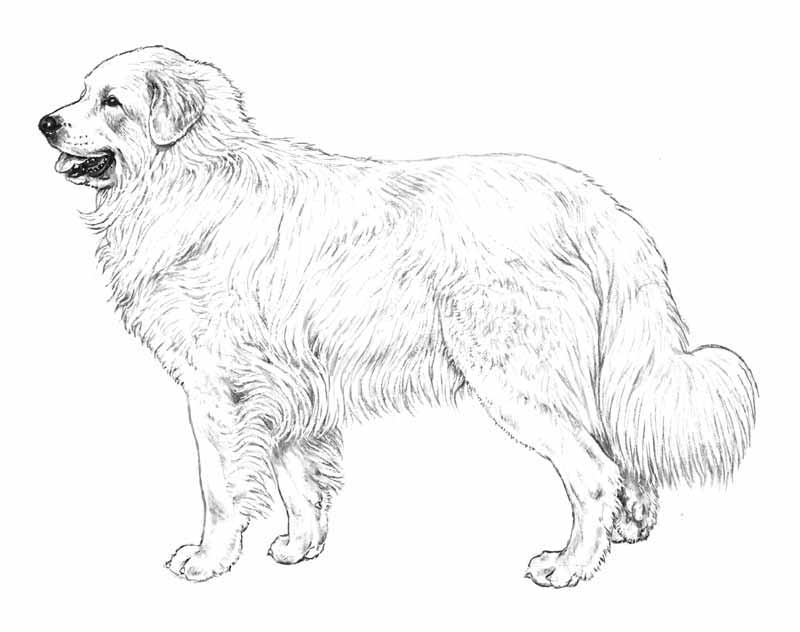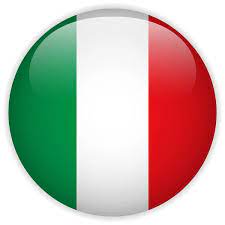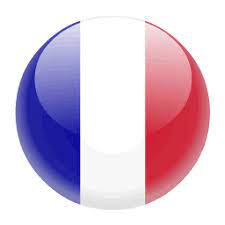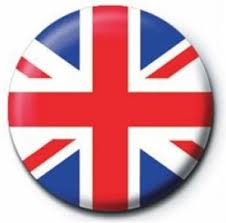
FCI Standard No. 137/ 31.03.2005
PYRENEES MOUNTAIN DOG
ORIGIN: France.
PUBLICATION DATE OF THE ORIGINAL VALID STANDARD: 03.13.2001. UTILIZATION: Sheep protection dog in the mountains.
FCI CLASSIFICATION: Group 2 Pinscher and Schnauzer type dogs, Molossians and Swiss cattle dogs.
Section 2.2 Molossoid, mountain dog type. Without proof of work.

GENERAL APPEARANCE: Large sized dog, imposing and strongly built, but not without a certain elegance.
IMPORTANT PROPORTIONS:
- The maximum width of the skull is equal to its length.
- The muzzle is slightly shorter than the skull.
- The length of the body, from the point of the shoulder to the point of the buttock, is slightly
higher than the height at the withers. - The height of the chest is equal to half the height at the withers or slightly less.
BEHAVIOUR-TEMPERAMENT: Used to autonomously guarantee the protection of the flocks against attacks by predators, its selection was based on its aptitude for guarding and deterring, as well as its attachment to the flock. The main qualities that result are strength and agility, as well as sweetness and attachment to the animals it has to protect. This protection dog tends a lot to independence and personal initiative so his master must know how to use a certain authority.
HEAD: Not too heavy compared to size. The sides of the head are quite flat.
CRANIAL REGION:
Skull: The maximum width of the skull is equal to its length. The skull is slightly domed due to the sagittal crest perceptible to the touch. The protuberance being evident
occipital, the skull, in its posterior part has an ogival shape. The superciliary arches are not marked. The metopic suture is barely perceptible to the touch, between the eyes.
Stop: With a gentle slope.
FACIAL REGION:
Truffle: Entirely black.
Muzzle: Broad, slightly shorter than the skull, tapering progressively towards the tip. Seen from above, it has a “V” shape with a truncated tip. It is well filled under the eyes.
Lips: Slightly hanging, so as to cover the lower jaw. Black or strongly marked with black, as well as the palate.
Jaws/Teeth: Full dentition with healthy white teeth. The bite is scissor bite (the upper incisors cover the lower incisors without loss of contact). A pincer bite is permitted, as are the two lower axes projecting forward.
Eyes: Rather small, almond-shaped, slightly oblique, with an intelligent and contemplative expression, amber-brown in colour. Eyelids always close fitting. Sweet and dreamy look. Ears: Set at eye level; quite small; triangular in shape and rounded at the tip. They hang flat against the head and are carried a little higher when the dog is alert.
NECK: Strong, rather short, with an underdeveloped dewlap.
BODY: The length of the body from the point of the shoulder to the point of the buttock is slightly greater than the height of the dog at the withers. The distance from the sternum to the ground is approximately equal to half the height at the withers, but never less.
Topline: Well sustained.
Withers: Broad.
Back: Of good length and solid.
Loin: Of medium length.
Croup: Slightly oblique with rather protruding iliac bones.
Flanks: Slightly falling back.
Chest: Not too let down but wide and deep. It goes down to elbow level, not lower. Its height is equal to or slightly less than half the height of the dog at the withers. The ribs are slightly rounded.
ARTS:
FRONT:
General appearance: Straight, strong.
Shoulders: Moderately sloping.
Arm: Muscular and of medium length.
Forearm: Straight, strong and well feathered.
Carpus: It is placed on the extension of the forearm. Metacarpus: Slightly oblique.
Forefeet: Slightly elongated, compact, with slightly arched toes.
REAR:
General Appearance: The hind legs have feathering which is longer and denser than the forelegs. Seen from behind, they are perpendicular to the ground.
Thigh: Well muscled, not too long and moderately oblique, well defined muscle. Knee: Moderately angled and parallel to the body.
Leg: Of medium length, strong.
Hock: Broad, lean, moderately angulated.
Hindfeet: Not long, compact, with moderately arched toes.
Dewclaws: The hind limbs each have double dewclaws and are well built. The forelegs sometimes have single or double dewclaws.
GAIT: The movement of the Pyrenean Mountain Dog is powerful and free, it never appears heavy, the movement is more ample than rapid and not without a certain elasticity and elegance. The dog’s angles allow for a brisk stride.
SKIN: Thick and supple, often with pigment spots all over the body.
COAT:
HAIR : Well dense, flat, fairly long and soft, fairly crisp on the shoulders and back, longer on the tail and around the neck where it may be slightly wavy. The hair of the “culotte”, finer and more woolly, is very dense. The undercoat is also very thick.
COLOUR: White or white with patches of a gray appearance (badger or wolf gray fur) or pale yellow or orange on the head, ears and root of the tail and sometimes on the body. The badger-colored spots are the most popular.
CUT IT:
Height at the withers:
Males: from 26,50 to 31,50 inches.
Females: 25,50 to 29,50 inches.
A tolerance of 0,8 inches is allowed. more in subjects perfectly in type.
DEFECTS: Any deviation from the above points must be considered as a defect which will be penalized according to its seriousness and its consequences on the dog’s health and well-being.
General Appearance:
- General appearance giving an impression of heaviness, without distinction. fat dog,
soft, lymphatic.
Head: - Head too heavy, rectangular in shape.
- Skull too broad, forehead rounded.
- Stop too pronounced or non-existent.
- Lips too pendulous.
- Insufficient pigmentation of the nose, eye fissures and the edge of the lips.
Eyes: - Round, pale, deep set or protruding eyes, too big or too small, set too close together or
too far apart. Third eyelid visible. Harsh expression. Ears: - Ears Wide, long, rolled in, with folds, carried back, set high.
Neck: - Slender neck, a little long or, on the contrary, too short, giving the impression that the head
is sunk in the shoulders. Dewlap too pronounced. Body: - Saddled or kyphotic topline, descending towards the front. Levrettato or drooping belly. Chest:
- Chest too wide or too narrow, ribs flat or, conversely, barrel-shaped.
Tail: - Tail with little hair or badly carried; tail too short or too long, without feathering; that does not
forming the wheel in motion, or forming it continuously, even when the dog is at rest.
Forelimbs: - Left-handed or doggy.
- Scapulo-humeral angle too open.
Hind limbs: - Vaccines or dogs.
- Hocks too straight or excessively angled.
Feet: - Long, flat.
Fur: - Short or curly coat, silky, limp or without undercoat.
DISQUALIFYING DEFECTS:
- Aggressive or overly shy subject.
- Any dog clearly showing physical or behavioral abnormalities must
be disqualified. Truffle: - Not completely black. Jaws:
- Overshot or undershot mouth, or any deformation of the jaws. Eyes:
- Eyelids depigmented. Yellow eye. Spurs:
- Absence of dewclaws; single or double atrophied dewclaws on hind legs. Color:
- Colors other than those indicated by the standard. Cut it:
- Out of bounds.
N.B.: - Males should have two apparently normal testicles fully descended into the
scrotum. - Only healthy subjects able to perform the functions for which they were selected, and whose morphology is typical of the breed, can be used for reproduction.


